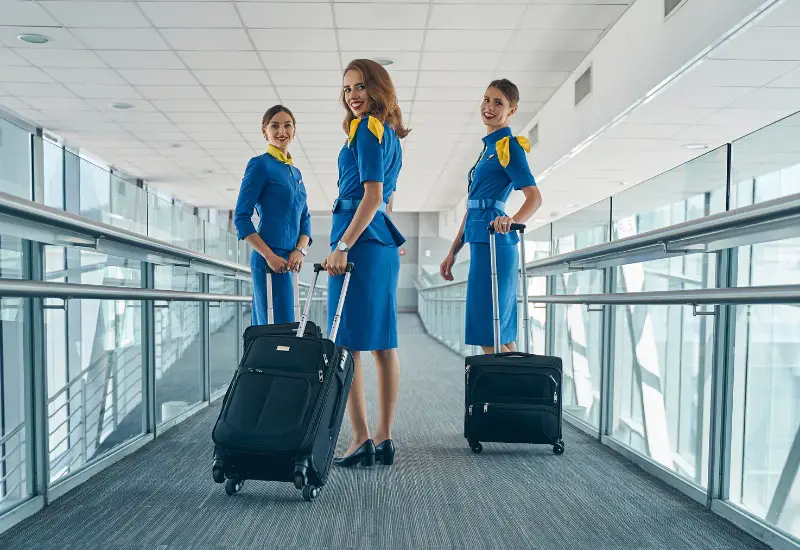The life of a flight attendant may appear glamorous – a reputation that it has worldwide-, but there are, as with all great jobs, drawbacks, and spending a lot of time away from home can be a big one.
Have you ever thought about how many days a month flight attendants work and how often they get to see their families?
There’s not really a straightforward answer that I can provide you, but I’ll do my best to give you as much info as I can from my own personal experience, as well as that of my colleagues.
The number of days a flight attendant gets to go home depends on their contract, the airline, and type of operation. Some flight attendants almost live in hotels and have “a life outside of work” of less than 10 days a month, while others go to work and come home every night like anybody else.
So let’s talk about this in more detail.
How Many Days Do Flight Attendants Work (And Get Off) Per Month?
The number of working days will depend on many factors:
- you’re a short-haul or a long-haul flight attendant
- your seniority
- your personal situation
- the airline.
Sorry, I know I keep saying ‘it depends’, but that is the nature of our industry, everything pretty much relies on a whole lot of other things
Short-haul vs Long-haul
Let’s say, for example, that you are a short-haul flight attendant.
In this case, you will fly domestic or shorter flights of two to five hours each. You would do trips of one to five days each and spend around 13-15 nights away from home.
Another option for short-haul flight attendants is to pick to fly turns – which means go out and come back home every day -.
You would make considerably less money, but this is what many flight attendants choose, after having children. They go to work around 5 a.m. and come home around 1 p.m. every day, just like a normal job!
Long-haul flight attendants could fly up to 13 or even more hours each leg; they would do just two flights each trip – there and back.
So if they have a 24-hour layover and around 3 trips per month, that means that in total, they could spend around 10-12 days away from home.
Seniority
Okay, let’s talk about seniority.
In the US, one of the most important factors that determine how many hours flight attendants will have or which trips they will get to work on is their seniority.
All crew have in mind a “perfect” schedule, and they bid (request) for it using a computer program that allows them to express preferences for constructing that monthly schedule.
Preferences may include the type of flying – domestic or international – layover locations, days off, single-day or multi-day trips, etc.
That way Crew Scheduling knows what they want.
But this doesn’t mean that they will get it, because all bids are awarded by seniority.
That means senior flight attendants will usually get the trips they want, leaving junior flight attendants with the ‘leftover’ trips.
Most Flight Attendants work between 9 and 22 days each month, again depending on their personal preferences and seniority.
A junior flight attendant could be working a schedule of 9-12 days off and a senior flight attendant one of up to 20 days off.
So seniority really is a big factor on how much time you will have at home.
Find out more about flight attendant schedules in my other article.
Commuting
Another factor that can affect how many days you work, is if you have to commute to your home from the base.
If you are living in a city different from your working base, you’ll need to commute long distances – probably by plane – so you might spend an additional 15-50 hours flying per month, not to mention the hours spent sitting around before you even start some of your days off in a hotel.
An example would be having a 6.00 a.m. start at the airport, which, in reality, means having to fly in the night before. Or in the opposite situation, you might not be able to go home until the next day once you finish work because the connecting flight for your commute doesn’t line up with your arrival time at the base.
Or something like this has happened to me many times: imagine that you are getting 3 days off but you finished late on your last working day, and your first flight home is in the evening the next day – which is your first day off-, then, your flight back is in the morning of your third day off. In the end, you get to spend only one full day at home. It might not be worth it to go home each time you are off.
Airline/country
Different airlines will also have different scheduling systems.
Some, like myself, can have a fixed roster pattern.
For example, I usually operate on a 5 days ON and 4 days OFF pattern.
This way, I have the opportunity to plan and in advance my time off for the whole year, because I can calculate which days I will work during any given period.
Some airlines in the Middle East or corporate aviation companies can have a set pattern of 15 consecutive days off and 15 days consecutive working days in a month.
So, for example, you could be off from the 1st to the 15th each month and work from the 16th to the 30th.
For some, this works well because they know exactly when they will be working, although for others, working 15 days at a time is a bit much.
So How Often Do Flight Attendants Get To Go Home and See Their Families?
As you can tell from reading the above, the answer is variable and depends on many factors.
Long-haul flight attendants will usually fly less number of trips – 3 to 5 maximum -, so they usually get more days off at home. Short-haul flight attendants might work more trips and have fewer days off.
But it could be the opposite, it depends on the company, and of course, the seniority too.
I know, I know, there’s that word, ‘depends’ again. Sorry, but that is the nature of our world.
But, despite what most people think, we can also have the option of sleeping at home every night if we do turns.
If the priority is to spend time with family, we might choose a schedule in which one flies to a destination and back all on the same day.
But again, please remember that everything goes in seniority order, so to secure your personal preferences, the more senior you are, the better.
So, while the work can be demanding, on the time you get to spend at home there are options that you can try out and see what works best for you.
I’m not saying that you will get the schedule that suits you perfectly, but explore what is possible and you may well be surprised.
So there we are, aviation is a world full of options and variables, and, I think, all the more wonderful for that!
Safe flying!



